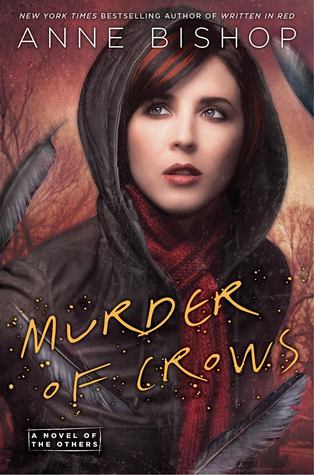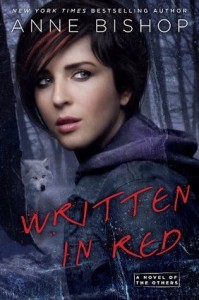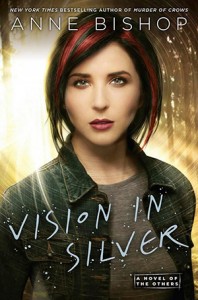 Murder of Crows (The Others, #2) by Anne Bishop
Murder of Crows (The Others, #2) by Anne Bishop Formats available: hardcover, paperback, ebook
Series: The Others #2
Pages: 354
Published by Roc on March 4th 2014
Purchasing Info: Author's Website, Publisher's Website, Amazon, Barnes & Noble, Kobo, Bookshop.org
Goodreads
Return to New York Times bestselling author Anne Bishop’s "phenomenal" (Urban Fantasy Investigations) world of the Others — where supernatural entities and humans struggle to co-exist, and one woman has begun to change all the rules
After winning the trust of the terra indigene residing in the Lakeside Courtyard, Meg Corbyn has had trouble figuring out what it means to live among them. As a human, Meg should be barely tolerated prey, but her abilities as a cassandra sangue make her something more.
The appearance of two addictive drugs has sparked violence between the humans and the Others, resulting in the murder of both species in nearby cities. So when Meg has a dream about blood and black feathers in the snow, Simon Wolfgard — Lakeside’s shape-shifting leader — wonders if their blood prophet dreamed of a past attack or a future threat.
As the urge to speak prophecies strikes Meg more frequently, trouble finds its way inside the Courtyard. Now, the Others and the handful of humans residing there must work together to stop the man bent on reclaiming their blood prophet—and stop the danger that threatens to destroy them all.
My Review:
 For a terrific laugh, read Cass’ absolutely scathing review of Written in Red, the first book in this series. Which she ends by saying that Anne Bishop remains inexplicably entertaining. Which she is. Then Cass turned around and reviewed Murder of Crows the following year, and while she loved hating Written in Red, she actually liked Murder of Crows. And so do I. (For those who remember the old Life cereal commercials, Cass is Mikey, she hates everything)
For a terrific laugh, read Cass’ absolutely scathing review of Written in Red, the first book in this series. Which she ends by saying that Anne Bishop remains inexplicably entertaining. Which she is. Then Cass turned around and reviewed Murder of Crows the following year, and while she loved hating Written in Red, she actually liked Murder of Crows. And so do I. (For those who remember the old Life cereal commercials, Cass is Mikey, she hates everything)
I finally got around to reading Written in Red as a tangent to some work I did for Novelist, and got absolutely hooked – to the point where I bought Murder of Crows and Vision in Silver just so I could keep going with the series. I was able to get Marked in Flesh from NetGalley, and I’ll be part of a gang-bang review of that next week at The Book Pushers. It turns out we’re ALL hooked on this series.
I’ve been putting off reading Murder of Crows, not because I didn’t want to read it, but because I knew I’d get sucked in and not emerge for hours, which is exactly what happened. I read it on Sunday. All of it. In one swell foop. So if you want to know what I did this weekend, the answer is mostly “read Murder of Crows and desperately resisted the impulse to read the rest of the series all night.”
Murder of Crows is the second entry in Bishop’s The Others series, and it provides a lot more information on this alternate history of the world, where all the wild things that came before humans are intelligent, powerful and in control of the world. The Others are sanguinati (vampires), animal shifters of all types, and elementals, at least so far. There’s one other who may be close kin to Death in the Discworld, or possibly all four of the Horsemen of the Apocalypse all rolled into one badass witch.
But this story isn’t about her. Instead, it’s about one very fragile human, Meg Corbyn, and her interactions with one of the Others urban outposts – the Courtyard in Lakeside. (I just realize that Lakeside might be Chicago, but I digress. And I might also be totally wrong.)
Meg Corbyn is a cassandra sangue, or blood prophet. When she bleeds, she spouts true prophecy and experiences extreme ecstasy. She’s also an escapee from a prison where she and others like herself are exploited, abused and ultimately die. If they aren’t ground up for parts first.
While Written in Red was the story of Meg’s adoption by the Lakeside Courtyard and her effects on its various residents, in Murder of Crows we see Meg more as the agent of her own life, and the impetus for a grand rescue of all of her fellow blood prophets. You could say that Written in Red was about Meg’s adaptation to the world, and that Murder of Crows is about the world’s adaptation to her.
We see this story play out from multiple perspectives. First there is Meg, learning to live on her own as a full person. While the Others in the Courtyard protect her for various reasons of their own, this is still the first time where Meg is living her own life and able to do what she wants. And also able to make her own mistakes.
By effectively adopting Meg as a mascot and pet, the Others in Lakeside have proclaimed her as one of their own, someone they will kill to protect. And when the Others protect, it isn’t just one on one – they have the power to level continents.
The Others in Lakeside find themselves changing to adapt to Meg’s presence in their midst. While the changes are most obvious in Simon Wolfgard – or at least obvious to everyone except Simon and Meg – everyone adapts somewhat.
One of the biggest adaptations is learning by necessity to see some humans not just as “not prey” but as actual kin. Meg is now one of their own, and as a human, Meg has gathered around herself a pack of her own humans, who are teaching her all the things about being human and female that her imprisoned life intentionally did not.
Just as Meg is “not prey”, her pack is also “not prey”. Even further, they are now beings whose thoughts, feelings and wishes must be considered carefully, if only because of the effect that they, in turn, will have upon Meg.
So it’s a calculated dance, to become human enough to relate to these humans in their midst, without losing their power of being terra indigene, or Other. That Simon, specifically, is becoming both a bit more human and a bit more wolf as he tries and mostly fails to figure out how he feels about Meg is fun to watch.
We also see a lot more of the organization and power of the Others in general. There is trouble brewing (being deliberately brewed) between the humans on this continent and the Others who own and control it. Humans, being human, think the continent belongs to them. Every time they overstep their very controlled bounds, the Others remind them of who is really in charge. The push and pull of this contest is often deadly, as the humans seem to have fatally short memories about the realities of their existence.
And we see the human side of this equation through the eyes of the Lakeside police, specifically Lieutenant Montgomery and Captain Burke. They are trying to forge a cooperative relationship with the Lakeside Courtyard, in the hopes that it will help Lakeside survive the storm that they know is coming.
So, while the operation in this particular story is the hunt for the imprisoned blood prophets and the punishment of those who have kept them captive and profited from their anguish, it is also a gathering of allies and a drawing of lines for the war to come.
Escape Rating A-: A “murder of crows” is a colorful collective noun for a group of crows, and yes, the murder of a group of crows in one of the opening events in this story. But because of Meg’s prophecies, it is a murder of crows and not a murder of Crows. The animals are killed in an attempt to reach the intelligent members of the Crowgard. And it is an opening salvo in someone’s misguided attempt to pit the humans against the Others, and to recapture Meg.
While the murder and the recapture fail, the attempts to pit the humans against the Others are all too successful, and escalating. Because I’m reading this in 2016 instead of 2013 when it was published, I’m seeing all too many parallels between the way that hatred is ginned up against the Others and the anti-immigrant and anti-Muslim attacks that are currently all too prevalent.
The difference in the story world is that what the humans keep forgetting is that the Others control everything – they own the land and all the natural resources upon it. They can disperse an entire town by not renewing its lease on the land it lives on. And anyone who has to travel from one town to another has to travel through woods the Others control and on roads they maintain.
And vampires can turn into smoke. And everyone who is still breathing needs air. Air is one of the Others. So is Thunder, and Fog, and Earthquake.
You get the picture, but so many of the humans in this story seem to forget, encouraged by race-baiting politicians.
But this is Meg’s story. Meg is, essentially, growing up. While she appears to be in her early-to-mid 20s, her life before the Courtyard was carefully protected and controlled. As she discovers more about herself, she is made aware that some of what she experienced was actually for her own protection, even as it also made her “gift” easier to exploit. The cassandra sangue have been bred to be so overly sensitive to outside stimuli that they need a controlled environment. They have also been bred to be both the strongest prophets possibly as well as increasingly susceptible to becoming addicted to the pleasure brought by cutting and prophesying.
Now that Meg is out in the world, she has to control her own environment, and find a way to control her biological need to cut and foretell. At the same time, the more that she learns, the more she is aware that her gift can save people. And while she fights the compulsion to cut too much, too often and too deep, she is also all too aware that her gift can save the lives of those she loves, even as it shortens her own.
She is trapped in a dilemma that she did not make but must navigate, not just for herself but for all the other cassandra sangue who will be released into the world if the Others’ quest to take down her former “owner” is successful.
I will also say that Cass was right. Meg is certainly, if not an actual Mary Sue, more than a bit too good to be believed outside the pages of fiction. Everyone she comes into contact with loves her, except of course, for those who just want to use her. While some of that insta-love is explained by the status granted to her by her gift, she is also just plain nice to everyone, and everyone loves her back. Even, seemingly, that lone horsewoman of the apocalypse I mentioned earlier.
Learning more about the world of the Others and the way that they operate was fascinating. There be worldbuilding here, and it helps ground the story. One of the fascinating bits, not completely in a good way, was the sudden outburst of the Humans First and Last neo-Nazi movement. History is completely against any attempt by humans to oust the Others from control. And that includes extremely recent history. Is the vast majority of the human population complete morons?
 The more I learn about this world, the deeper I want to dive. This weekend, I’ll get my wish and read both Vision in Silver and Marked in Flesh. And I can hardly wait!
The more I learn about this world, the deeper I want to dive. This weekend, I’ll get my wish and read both Vision in Silver and Marked in Flesh. And I can hardly wait!
